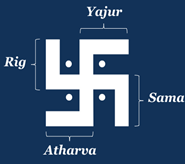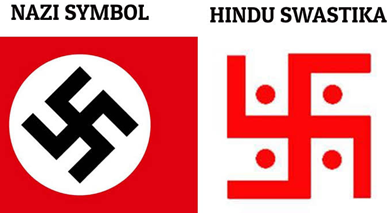Context
Recently, States in Australia are cracking down on the use of the swastika, and Dutch police are tracking miscreants who recently displayed the sign.

About the swastika a Hindu religious symbol
- The word swastika comes from the Sanskrit roots su(good) and asti (to prevail), meaning wellbeing, prosperity or good fortune, and has been used in the prayers of the Rig Veda, the oldest of Hindu scriptures.
- In India, swastika is understood to be a symbol of auspiciousness and good fortune, and is regularly donned on Hindu homes, businesses, printed materials, cars, temples, and ashrams.
- They can be interpreted as the four Vedas (Rig, Yajur, Sama, Atharva), the core Hindu scriptures.
- They can be thought of as the four goals of life: Dharma, Artha, Kama, Moksha (right action, worldly prosperity, worldly enjoyment, and spiritual liberation).
- The limbs are also interpreted as representing the four seasons, the four directions, and the four yugas, or epochs (Satya, Treta, Dvapara, Kali).
- The swastika has a civilisational presence in India.
- The word swastika has a Sanskrit root, which means good fortune or well-being, and it has been an auspicious symbol for Hindus over many millennia.

|
Hakenkreuz or Hooked Cross
- The Hakenkreuz or Hooked Cross is a Christian symbol, that became the emblem of the Nazi Party in 1920.
- It was Hitler, who designed the flag of the Nazi party. He used the black, red, and white colors from the old German imperial flag to connect the past with the future.
- However, he gave a whole new meaning to this flag where the white color portrayed nationalism, the red color stood for the social idea of the movement, and the Hakenkreuz was used to reflect the importance of the Aryan race.
- In 1925, Hitler mentioned this in his autobiography Mein Kampf.
|
How Indian swastika is different from black hakenkreuz?
- Unlike the black hakenkreuz of the Nazis, the swastika used by Indians is usually red or yellow in colour, is not tilted to the right, and has dots at each corner, which are believed to represent the four Vedas.

What’s wrong with the swastika symbol?
- Despite its association for centuries with the symbolism and practice of the Hindu, Buddhist, and Jain religions, many people in Europe and America see the swastika only as the defining symbol of the antisemitic, racist, fascist Third Reich (1933-1945) of Adolf Hitler.
- After the defeat of Nazism and the end of World War II, the swastika was banned in Germany and subsequently in other European countries such as France, Austria, and Lithuania.
- Neo-Nazi groups around the world, however, continued to use the symbol and flag to rally support, and to identify themselves.


